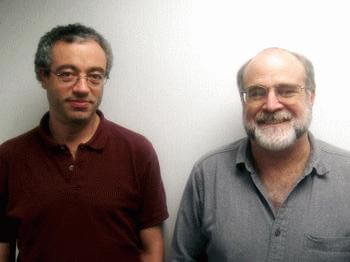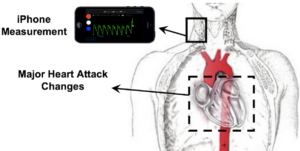
Coordinators’ Coordinators: Pedro Szekely, left, and Robert Neches
The plan was for company A to secure the northern approach to the target, a suspected enemy concentration, but company A is bogged down in traffic. The commander frowns at the map visible on his combat computer; but opens an option screen. And the USC Viterbi School Information Sciences Institute Coordinators system has suggestions, complete with pre-set orders for all the units that will be affected.
Created by ISI and partners, the DARPA-funded system is designed to help combat commanders make correct decisions in complex, fast-changing conditions. It may be in field trials in a year, following an outstanding performance in recent competitive tests.Robert Neches and Pedro Szekely of ISI led the team that created the “Coordinators” system, including researchers from Vanderbilt University’s Institute for Software Integrated Systems and the Palo Alto, California-based Kestrel Institute as well as from ISI. The technology supporting the coordinators system is the result of more than two years of intensive research.
Neches is director of the Distributed Scalable Systems Division at USC ISI and a research associate p;rofessor in the Viterbi School’s Computer Science Department and has been collaborating with Szekely on decision aiding systems for a decade.

Left: commander’s map view of operation
The Coordinator System sets up teams of computer advisors (coordinators) who interact with humans to help execute complex plans involving multiple simultaneous activities by numerous independent teams.
Each team leader has a coordinator. If the operation is proceeding according to plan, the system shows the commander and all the team leaders that all is in order. If it is not, the system helps the commander and his teams get it back on track.
The commander and his subordinates are connected with linked computer screens with alternating views. One shows a map of the area, with the various units moving around it.
A second view shows a time line graph of the planned operation, with a red line — the present — moving to the right through bars, each bar representing a unit, with the unit’s responsibility at any given time labeled on the bar.
The commander sees all the different units. Each unit leader just sees his own.
In addition to the flesh-and-blood humans who are looking at the screens, the system contains their computer double coordinators, programs that communicate with each other continually.
If something happens not according to plan, the coordinator of the challenged team alerts the commander, whose display changes to explain what’s happening, a delay for example, and proposes options to the commander, in a click-to-select format. The coordinator also displays this information to the local team leader.
When the commander selects an option, the system transmits the decision to all affected units, who then confirm their activity.
For example, the Coordinator demonstration presents a cordon-and-search scenario in which a force, divided into a number of separate detachments is trying to reach and search two houses suspected of sheltering enemy forces, first putting forces in place to control access to the location, then moving the forces for the actual assault past them into position, and hen coordinating with helicopters.
All kinds of things can go wrong, from taking longer than expected to reach a point, to angry civilians in the wrong place, to a downed helicopter. The system reacts in real time to the events, with the computer doubles analyzing the problems and proposing integrated solutions and, most important, coordinating the execution of these changed plans to units stay on the same page.
In fast moving actual combat situations, decisions must be made quickly and the ‘fog of war’ makes it difficult to keep track of all the consequences of the changes. The most tragic consequence can be “friendly fire” casualties.
Outstanding performance
In tests conducted by DARPA in mid July the Coordinators system competed against similar systems created by two other multi-institutional teams, working on scenarios created by a DARPA contractor.
Each system was judged on its performance on each step of the operation on such factors as speed, and coordination accuracy, and ability to deal with very dynamic and fast- changing situations. The Coordinators system performance was the best of the three almost 98 percent of the time. Not only did the USC system find the best solution almost all of the time, but the quality of the solutions were measurably superior.
Across all problems, the USC/ISI team found 99.9% of the best answers available. The other two teams found 60.7% and 68.9%, indicating that the USC/ISI team’s answers were not just better in most cases but were also almost invariably better by an extremely strong margin.
The latest tests mark the end of phase 2 of the project, and are the second consecutive outstanding performance by the USC/ISI Coordinators system. The system also performed exceptionally in comparative tests ending phase 1, with Neches and Szekely’s team receiving a plaque from DARPA in May 2006, “In recognition of the unmatched performance of their Criticality-Sensitive Coordination System…”.
Besides Neches and Szekely, other ISI CSC team members include computer scientists Craig Milo Rogers, Rajiv Maheswaran, and Romeo Sanchez; and grad students Nader Noori, Jing Jin, and Po-An Chen. Additional support was provided by Vanderbilt University and Kestrel Institute.
The technology supporting the coordinators system is the result of more than two years of intensive research. The next step, according to Neches, will be exercises in which the system is tested in the field and then actually put in the hands of soldiers.
Published on September 13th, 2007
Last updated on June 7th, 2024









